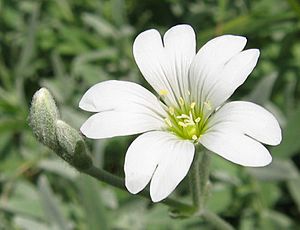Cerastium tomentosum facts for kids
Quick facts for kids Cerastium tomentosum |
|
|---|---|
 |
|
| Scientific classification | |
| Genus: |
Cerastium
|
| Species: |
tomentosum
|
Cerastium tomentosum, often called snow-in-Summer, is a beautiful flowering plant. It's part of the Caryophyllaceae family, which includes many types of flowers. You can easily spot it because its leaves feel soft and fuzzy, almost like felt! This plant grows low to the ground and comes back every year. It originally comes from the cold, high mountains of Europe. Its stems and leaves are a lovely silvery-grey, and its flowers are white and shaped like stars, about 1.5 centimeters wide.
What Does it Look Like?
Snow-in-Summer is a plant that stays green all year. It spreads out along the ground and grows back every year (this is called a perennial plant). It can grow to be about 15 to 30 centimeters tall, sometimes even up to 45 centimeters. The whole plant is covered in thick, soft hairs.
Its leaves can be up to 3 centimeters long. They are long and narrow, like a spear tip (this shape is called lanceolate). These leaves are covered with shiny, silvery, curly hairs that are all tangled together, making them look like white felt.
The flowers grow in clusters, with up to 15 flowers in each group (this cluster is called an inflorescence). Each flower has a green outer part called the calyx, which is about 5 to 7 millimeters long. The white petals are twice as long as the calyx. After the flowers bloom, they form a small seed pod called a capsule. The capsule's teeth bend slightly outwards. This plant usually blooms from May to July in the northern part of the world, but it can sometimes flower at other times too.
Growing Snow-in-Summer
Snow-in-Summer is a very popular plant for gardens all over the world. It's a great plant for rock gardens because it forms thick, silvery carpets that look beautiful. This plant is not very picky about where it grows. It likes soil that isn't too rich, with lots of gravel, and it needs good drainage so water doesn't sit around its roots. It also loves sunny spots. It spreads easily by sending out underground stems called rhizomes, which helps it cover more ground.
Where Does it Grow?
This plant is originally from southern Italy. Scientists believe it first came from the Caucasus region and southeastern Europe. Over time, it has spread and now grows naturally in places like Canada, the United States, and France. In these new places, it often grows on its own, even if it wasn't planted there.


